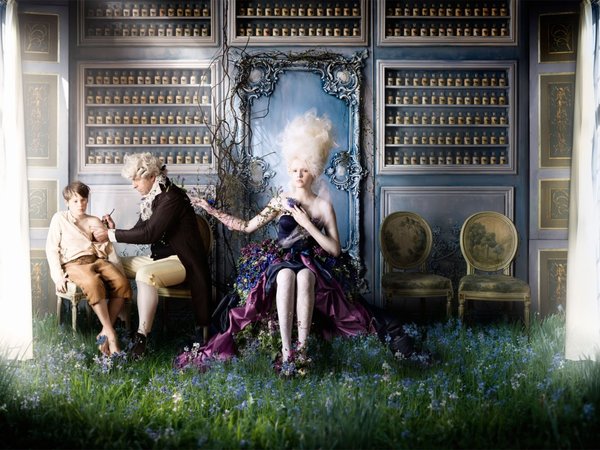The Art of Saving a Life is a collection of stories about how vaccines continue to change the course of history. It offers an opportunity to hear, see and feel the tremendous impact of immunization, and to energize us in the global effort to protect every child from life-threatening disease.
The Bill & Melinda Gates Foundation commissioned 30 world-renowned photographers, painters, sculptors, writers, filmmakers, and musicians created representations focused on the past, present and future impact of immunization.
We’ve collected some of our favorite works to share with you. Which do you like the most?
Set in an 18th century English doctor’s surgery, this stunning portrait features Dr. Edward Jenner inoculating James Phipps, the first person to receive the smallpox vaccine. Dr. Jenner’s pioneering work in the late 18th century led to the eradication of smallpox in 1980.
Alexia created and photographed the entire tableaux. The aristocratic woman in the center represents how smallpox did not discriminate, affecting the rich and poor alike. The many flowers throughout the piece symbolize the global impact of smallpox, and the skulls on every bottle the ephemeral nature of life and death.

Vik Muniz: Flowers – The Beauty of Vaccines
At first “Flowers” looks like a textured painting, or perhaps a fabric print. But peer in closer, and there emerge the tiny cells that create this image. As artist Vik Muniz writes: “The artwork is a microscopic pattern of liver cells infected with a smallpox vaccine virus. After infection, the virus turns the cells a reddish color which allows scientists to visualise infection.”
The image was created in a laboratory using microfabrication techniques and a high-resolution microscope. Vik then digitally colors the images and makes wall-sized prints “that allow viewers to see both the individual cells, and the pattern as a whole.”

Mauro Perucchetti: Vaccines as Love Serum
Mauro Perucchetti melds his classic resin sculptures into one big message for children’s health. In colorful pigmented resin, Mauro blends two of his best known sculptures: Jelly Baby Family, which embodies family unity and multiculturalism, and Love Serum, that could “inoculate the whole world.”
Mauro hopes the toy-like appearance of his work will help bring a smile to children, and eliminate fear of syringes and needles, while also eliminating the scepticism some parents have about vaccines. To tailor his work even more to the project, Mauro’s original Love Serum contained hearts, now transformed to happy faces, and he has added a safety tip to the syringe so that no one pricks a finger.

Evgeny Parfenov: James P. Grant and the Child Survival Revolution
Evgeny Parfenov introduces his touching vision of James P. Grant, the man who led UNICEF from 1980-1995. James P. Grant’s leadership of the “child survival revolution” resulted in rapid improvements in immunization coverage in poor countries. Evgeny chose to portray Grant, who passed away in 1995, as serene and wise.
He placed special focus on the birds in the portrait, which are “dispersed slightly at random, as if they are at play, like children.” Evgeny writes, “We see several birds in the foreground taking flight from Grant’s face, as if they owe their lives and their freedom to the outcome of his mission, his hard work, his struggle, with wrinkles summarizing the trials he has been through, his life’s work, and his wisdom.”

Han Feng: Health Workers are Superheroes
Chinese artist and designer Han Feng knew that health workers had to have practical clothing, but she also wanted to insert a bit of glamour, to reflect their role as heroes to many. With a big nod to China’s famous rural community “barefoot doctors”, and recognizing that health workers often come from villages with limited resources, Han fashioned a jacket out of old Chinese military uniforms.
Lined with an inner layer of cotton for comfort and ventilation, this utilitarian jacket with flamboyant tailoring not only has pockets positioned for the vital tools and equipment needed to deliver vaccines, it also features embroidery of imagery and text in childlike broad strokes, highlighting health workers’ passion and devotion to the cause and the hopes and future they bring to children and their family.
Sophie Blackall takes us on an adventure, in a quest to find every child. Currently, more than 20 million children are not receiving the vaccines they need. Sophie brings these children to life, illustrating corners of the world where children can be missed – whether in remote mountain valleys, desert villages, refugee camps or dense urban slums.
We are invited to search for these children, and once we find them, to think about their similarities and the challenge of reaching each of them, seemingly buried like the proverbial needle in a haystack. The illustrations also celebrate the fact that in many places, these children are indeed being found, and given the vaccines and other health services that are every child’s right.







